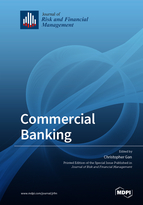Commercial Banking
A special issue of Journal of Risk and Financial Management (ISSN 1911-8074). This special issue belongs to the section "Banking and Finance".
Deadline for manuscript submissions: closed (28 February 2021) | Viewed by 34382
Special Issue Editor
Interests: commercial banking; micro-finance; rural finance; development economics; financial economics; Asian economy; banking; digital finance; cyber risk and cyber fraud
Special Issue Information
Dear Colleagues,
As we are all aware, the credit market is characterized by information asymmetries between lenders and borrowers. This information imbalance has significant consequences for the decision-making processes used by parties such as individuals in households, businesses and governments who want to optimise their use of credit. Borrowers typically know the limits of their resources and understand risk better than lenders, whilst entrepreneurs in particular possess inside information about their own projects for which they seek financing. A better understanding of borrower characteristics could benefit the lender but the moral hazard problem prevents the direct transfer of information between the two participants.
The existence of financial intermediaries is arguably an artifact of information asymmetry. Beyond simple financial transactions, financial intermediation provides a mechanism for information transmission, which can reduce the degree of information asymmetry and consequently increase market efficiency. During the process of information transmission, the bank is able to provide unique services in the production and exchange of information. Therefore, banks have comparative advantages in information production, transmission, and utilisation.
In credit provision, it is possible for lenders to make Type I and Type II errors. These types of errors are associated with whether banks decide to lend money to borrowers with low repayment capacity or risk missing out on potentially profitable lending. However, the recent US subprime loan crisis and previous financial crises (such as the Mexican, Argentinian, Chilean and Asian financial crises) show it is possible that banks can make both good and bad lending decisions. Does this mean that banks have lost their comparative advantages in leveraging information asymmetry?
The special issue welcomes contribution in empirical methods in banking such as bank loans announcement, credit constraints, capital regulation and bank behaviour, bank regulation on bank performance, corporate governance in banking, maturity transformation risk in banking and bank’s merger and acquisition.
Prof. Dr. Christopher Gan
Guest Editor
Manuscript Submission Information
Manuscripts should be submitted online at www.mdpi.com by registering and logging in to this website. Once you are registered, click here to go to the submission form. Manuscripts can be submitted until the deadline. All submissions that pass pre-check are peer-reviewed. Accepted papers will be published continuously in the journal (as soon as accepted) and will be listed together on the special issue website. Research articles, review articles as well as short communications are invited. For planned papers, a title and short abstract (about 100 words) can be sent to the Editorial Office for announcement on this website.
Submitted manuscripts should not have been published previously, nor be under consideration for publication elsewhere (except conference proceedings papers). All manuscripts are thoroughly refereed through a single-blind peer-review process. A guide for authors and other relevant information for submission of manuscripts is available on the Instructions for Authors page. Journal of Risk and Financial Management is an international peer-reviewed open access monthly journal published by MDPI.
Please visit the Instructions for Authors page before submitting a manuscript. The Article Processing Charge (APC) for publication in this open access journal is 1400 CHF (Swiss Francs). Submitted papers should be well formatted and use good English. Authors may use MDPI's English editing service prior to publication or during author revisions.
Keywords
- capital regulation
- systemic risk
- risk management
- information asymmetries
- moral hazard
- adverse selection
- liquidity
- Basel accord
- merger and acquisition
- credit risk





